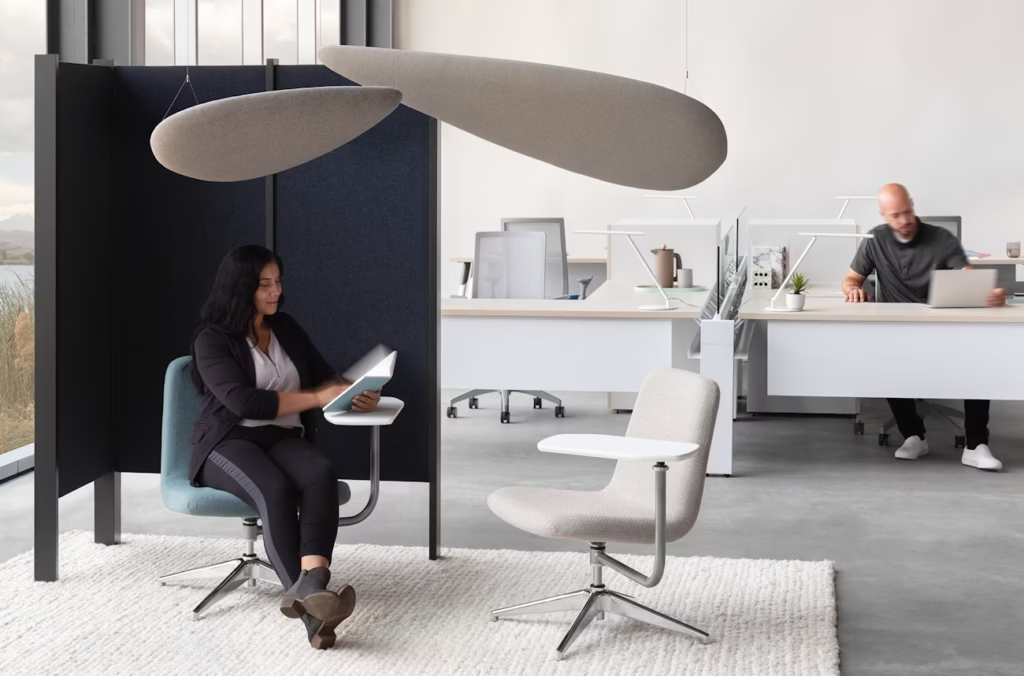Misophonia is a condition where certain everyday sounds such as chewing, pen clicking, or tapping can trigger intense emotional reactions like irritation, anxiety, or anger. These responses go beyond typical annoyance and can make it very difficult to concentrate, stay calm, or feel comfortable in shared spaces.
For students and professionals, misophonia can turn classrooms, offices, or group settings into stressful environments. Constant exposure to triggering sounds may impact focus, productivity, and relationships with others.
Although misophonia is not yet widely recognized in many schools or workplaces, awareness is growing. The good news is that there are practical ways to manage it. In this blog post, we will explore strategies to help you cope with misophonia at work or school, including how to minimize exposure to triggers, communicate your needs, and create a more supportive daily environment.
What Is Misophonia?
Misophonia is a condition where certain everyday sounds cause strong emotional or physical reactions. Common trigger sounds include chewing, breathing, pen clicking, foot tapping, or throat clearing. These sounds can lead to feelings of irritation, anxiety, disgust, or anger, even if they seem minor or unnoticeable to others.

The word misophonia means “hatred of sound,” but the condition is more complex than simply disliking noise. The reactions are not a personal choice. They happen automatically and can feel overwhelming. Experts believe misophonia is related to the way the brain processes certain types of sound, although the exact cause is still being researched.\
Recommended: How to Support Immune Health During Cold Season
The impact of misophonia can vary. Some people experience mild discomfort, while others may feel deeply distressed. It can interfere with daily life, especially in places like classrooms or workplaces where trigger sounds are difficult to avoid.
While misophonia is not currently classified as an official mental health disorder, it is increasingly recognized by healthcare professionals. Many people find relief through coping strategies, sound management techniques, and support from professionals or peers who understand the condition.
Recognizing Your Triggers and Symptoms
One of the most important steps in managing misophonia is understanding what specifically sets off your reactions. Misophonia triggers are often everyday sounds that may seem minor to others but cause a strong emotional or physical response in you.
Common Triggers
Triggers can vary widely from person to person. Some of the most common include:
- Mouth sounds such as chewing, slurping, or gum popping
- Breathing sounds, including sniffing or loud nose breathing
- Repetitive tapping, pen clicking, or keyboard typing
- Footsteps, chair squeaks, or rustling paper
- Throat clearing or coughing
Recommended: What Is Winter Depression? 6 Tips To Help You Treat It
Visual triggers can also be present, especially when they accompany sounds. For example, seeing someone chewing with their mouth open can intensify the reaction.
Creating a Misophonia-Friendly Workspace or Study Environment
Once you have identified your triggers, the next step is to shape your environment in a way that helps reduce exposure to them. While it may not be possible to eliminate every sound, small changes in your workspace or study area can make a big difference in your ability to stay focused and calm.
1. Use Noise Management Tools
Sound control is one of the most effective ways to manage misophonia. Consider using:
- Noise-canceling headphones to block or reduce background noise
- White noise machines or apps that play calming sounds like rain, waves, or soft music
- Earplugs for quiet settings where headphones may not be appropriate
- Soundproofing materials such as rugs, curtains, or foam panels to absorb noise in the room
These tools can help mask triggering sounds and give your brain something more neutral or pleasant to focus on.
2. Choose Your Location Carefully
Whenever possible, try to:
- Sit away from high-traffic areas or noisy equipment
- Position yourself near natural sound barriers such as walls or bookshelves
- Request seating preferences in classrooms or shared office spaces if allowed
Even small shifts in seating can reduce the intensity of certain triggers.
3. Create Visual and Physical Boundaries
Although misophonia is triggered by sound, visual distractions often go hand in hand with auditory ones. Consider using:
- Desk dividers or privacy panels to create a visual buffer
- Plants or decor that create a sense of calm and separation
- Noise-reducing furniture such as padded chairs or soft materials that help absorb sound
Recommended: Can Red Light Therapy Cause Cancer?
These additions not only limit exposure to distracting movement but also contribute to a more peaceful atmosphere overall.
4. Personalize the Environment for Comfort

Bringing small personal touches into your space can help you feel more in control and at ease. Try adding:
- A calming desk setup with minimal clutter
- Personal items that promote relaxation, such as photos or soft lighting
- A small toolkit of coping aids like a stress ball, essential oil roller, or grounding object
The goal is to create a space that supports your focus and helps lower your baseline stress level.
5. Work with What You Can Control
You may not be able to control every aspect of your environment, especially in shared spaces. However, focusing on what you can adjust, such as your seating, the tools you use, or how you respond to noise, gives you a sense of agency and helps reduce feelings of helplessness.
Practical Coping Strategies for Immediate Relief
When a misophonia trigger strikes, it can feel overwhelming and difficult to manage in the moment. These five practical strategies are designed to help you calm your nervous system, regain control, and stay focused, even when you’re in a shared space like a classroom or office.
1. Block or Mask the Sound
If possible, use noise-canceling headphones or discreet earplugs to reduce the impact of the triggering sound. Listening to soft music, white noise, or ambient sounds such as rain or ocean waves can help mask the trigger and create a more neutral sound environment. If headphones aren’t an option, even cupping your hands over your ears briefly can offer some relief.
Recommended: Ignoring Someone With Histrionic Personality Disorder
2. Regulate Your Breathing
When you hear a trigger sound, your body may respond with tension, rapid heartbeat, or shallow breathing. A simple breathing exercise can help reset your stress response. Try inhaling slowly through your nose for four seconds, holding that breath for four seconds, and then exhaling through your mouth for four seconds. Repeat this pattern a few times to help calm your body and mind.
3. Use a Grounding Object or Sensory Tool
Having a small item nearby can help redirect your attention away from the trigger. This could be a textured object like a smooth stone, a fabric keychain, or a stress ball. Some people find comfort in using essential oils or a scented hand cream they can apply discreetly. Engaging your sense of touch or smell can help anchor you in the present moment and reduce emotional intensity.
4. Step Away if Possible
If the sound becomes too overwhelming and it’s appropriate to do so, give yourself permission to step away from the situation. Excuse yourself to the restroom, go for a short walk, or move to a quieter spot if one is available. Even one or two minutes away from the source of the trigger can give you time to reset and regain your sense of control.
5. Redirect Your Focus with a Mental Task
Giving your brain something else to focus on can help you detach from the emotional reaction caused by the trigger. Try mentally counting backward from 100, listing items in a specific category like types of animals or countries, or silently repeating a calming affirmation or phrase. These mental distractions give your brain a break from the stress response and help you feel more grounded.
Recommended: Why Does My Leg Vibrate Like My Phone Is Ringing?
What to Avoid: Common Pitfalls and Mis-steps
While learning how to manage misophonia, it’s just as important to recognize what not to do. Certain habits or responses may seem helpful in the moment but can actually make symptoms worse over time. Being aware of these common missteps can help you build a more effective, long-term coping strategy.
1. Suppressing Your Emotions Without Addressing the Trigger
Trying to hide or ignore your reactions completely may seem like the professional or polite thing to do, but it often leads to emotional buildup. When you continuously suppress how you feel without any outlet or coping tool, the stress can grow until it becomes harder to manage. Instead, acknowledge your response internally and use healthy strategies to calm yourself.
2. Avoiding All Social or Shared Environments

It can be tempting to isolate yourself to avoid triggering sounds altogether. While occasional breaks are helpful, avoiding group settings completely may lead to social withdrawal or increased anxiety. The more you avoid, the harder it becomes to function in necessary environments like work or school. Gradual exposure with supportive tools can help you build tolerance while staying engaged.
3. Confronting Others in Anger or Frustration
In moments of distress, it can feel natural to snap at someone who is making a triggering sound. However, reacting with anger often leads to misunderstanding, tension, or damaged relationships. If you need to address a sound with someone, wait until you are calm and choose a respectful, non-confrontational approach.
4. Assuming People Will Automatically Understand
Most people are not familiar with misophonia and may not realize how deeply certain sounds affect you. Expecting others to automatically adjust without communication can lead to frustration on both sides. Whenever possible, explain your needs clearly and calmly so others can better understand how to support you.
5. Relying Only on Avoidance Instead of Building Coping Skills
While avoidance can offer short-term relief, it does not teach your brain how to handle triggers over time. Relying only on avoidance can make your sensitivity worse. A more helpful approach is to combine occasional avoidance with strategies like breathing, distraction, and sound masking, so you build resilience while still protecting your well-being.
Conclusion
Living with misophonia can be challenging, especially in environments where you have limited control over the sounds around you. Whether you’re in a classroom, an office, or another shared space, the key to managing misophonia is awareness, preparation, and self-compassion.
By recognizing your triggers, creating a supportive environment, using practical coping strategies, and avoiding common missteps, you can reduce the impact of misophonia on your daily life. While the condition may not go away completely, it is possible to build routines and responses that help you feel more in control and less overwhelmed.
